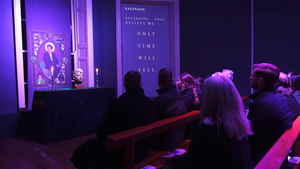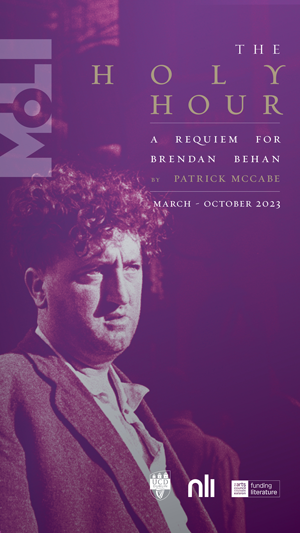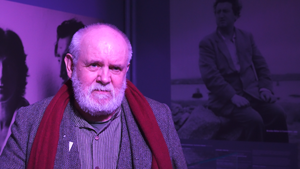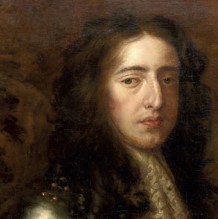‘THE HOLY HOUR: A REQUIEM FOR BRENDAN BEHAN’
Published in Issue 3 (May/June 2023), Reviews, Volume 31Museum of Literature Ireland, www.moli.ie
By Donal Fallon
This year marks the centenary of the birth not only of Brendan Behan but also of his contemporary and friend Anthony Cronin. In one of the most celebrated memoirs of twentieth-century Ireland, Dead as doornails, Cronin painted a vivid and often tragic picture of bohemian Dublin in the 1950s. Brian O’Nolan (in a variety of guises), Patrick Kavanagh and Brendan Behan all emerge from the tale as brilliant but troubled figures, in conflict not merely with each other but also with themselves. Behan, Cronin would later recall, ‘had a voracious appetite for public notice’. It was to be his undoing. Cronin died in December 2016, leaving behind an impressive body of work spanning poetry, biography, fiction and literary criticism. By comparison, Behan has been gone for almost six decades and has left a relatively small output behind him.

Stepping into MoLI’s temporary exhibition space, we have the feeling of entering a church. (Luke Brabazon)
In the public mind, Behan is recalled primarily for two stage productions, The hostage and The quare fellow, as well as his prison memoir, Borstal boy, published in 1958 at the height of his stardom. This centenary year has seen a fuller consideration of Behan as a writer, with the publication of John Brannigan’s A bit of a writer finally gathering all of Behan’s journalistic output in one place. Similarly, ‘The Holy Hour: A Requiem for Brendan Behan’ attempts to move beyond the more familiar to give us a rounded picture of Behan. That Brendan Behan is a difficult character to untangle is obvious. His friend and publicist Rae Jeffs alluded to this in the title of her memoir of Behan, Man and showman. Both Behans emerge in Patrick McCabe’s playful examination of the life of the writer. For the author of The butcher boy and Breakfast on Pluto, Brendan Behan was a defining influence, McCabe insisting that ‘Borstal boy by Brendan Behan was the most formative book I read growing up. A lot of books I read then came from an Ireland I didn’t recognize.’
Stepping into MoLI’s temporary exhibition space, we have the feeling of entering a church. A hand-out, akin to the order of Mass, tells the visitor what to expect. In segments labelled ‘Introitus’, ‘Kyrie’, ‘Graduale’, ‘Sanctus’ and ‘Agnus Dei’, we’re encouraged to ‘All stand for the beginning of service’ or ‘All sit for the reading’. No one seems to play along with the ritual, but the feeling of a church space is well evoked by church pews. On one of them a commemorative plaque honours Charlie Milwall (my ‘china plate’, as Behan had it in cockney rhyming slang) from Behan’s Borstal days. On an altar we see a bronze bust of Behan, the work of artist Irene Broe. (Some of Broe’s work can be seen across the city today, including the statue of St Valentine in Whitefriar Street church.) Artist Lucy Smyth’s backdrop is akin to a stained-glass window, adding to the atmosphere of piety.
For the most part, ‘The Holy Hour’ is an audio-visual journey into the imagined inner mind of Behan. There is an array of brilliant voice performances in the work, capturing accents like the inner-city Dub-a-lin of Behan, the Monaghan accent of Patrick Kavanagh and the plummy British broadcaster, what we might call ‘the BBC accent’. Surprisingly, nearly all the characters we hear are voiced by Patrick McCabe himself. McCabe has surely come closest to capturing the voice of Behan since Niall Tóibín and, like Tóibín, gives us not merely the spoken word but also the rambunctious singing. Near the conclusion of the work, actor Roxanna Nic Liam reads Philip Larkin’s poem ‘Dublinesque’, an interesting choice of poem from outside the Irish literary canon. (Larkin, living and working in Belfast in the early 1950s, made a number of visits to Dublin, later reflecting that ‘I prefer Belfast to Dublin—not architecturally of course, but architecture isn’t everything’.)
In Behan’s mind, we hear conflicting voices. There’s the scornful Paddy Kavanagh, who mocks him over his declining output. Later Behan publications, like Brendan Behan’s New York, Brendan Behan’s island and Confessions of an Irish rebel were essentially dictated by Behan into a tape recorder, and in this work we hear Kavanagh ask him, ‘What bloody buke are you tape-recording now?’ There are encouraging voices as well, like that of Beatrice ffrench-Salkeld, Behan’s wife and closest friend. McCabe has dug into the archives too, and alongside his imagined conversations, self-doubts and dialogues we get historical nuggets, like the theatre critic Kenneth Tynan’s observation that ‘It is Ireland’s sacred duty to send over, every few years, a playwright to save the English theatre from inarticulate glumness’.
Fundamentally important to any understanding of Behan is the Irish language, with his poetry in the native tongue displaying a surprising tenderness. Here, ‘Jackeen ag Caoineadh na mBlascaod’, Behan’s poem to the Blasket Islands, written while behind bars in Mountjoy, is brilliantly evoked.
Rare archival footage of Behan’s funeral at Glasnevin Cemetery is utilised in the concluding moments of the work. Joan Littlewood, the theatre director who championed Behan’s work, remarked on hearing of Behan’s passing that ‘I was so angry with Brendan for dying that I felt like kicking that coffin’.
There are just a few artefacts displayed at the back of the room, in the form of an assortment of Behan publications and some LPs. Given MoLI’s relationship with the National Library of Ireland, it seems a pity not to see the rare images of Behan’s wedding which the library displayed on RTÉ News on the date of Behan’s centenary. ‘The Holy Hour’ is not an exhibition as such, though, but rather a requiem for Brendan Behan. Full of humour, and serious when it needs to be, it will surely be a highlight of Behan’s centenary year.
Donal Fallon is presenter of the Three Castles Burning podcast and author of 14 Henrietta Street: from tenement to suburbia (Dublin City Council, 2021).



















